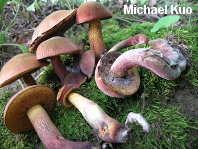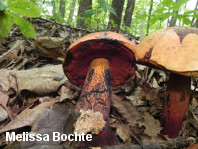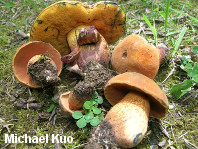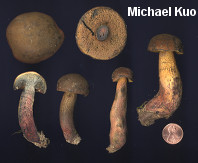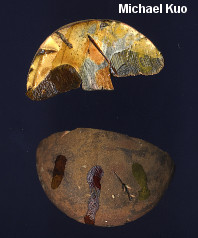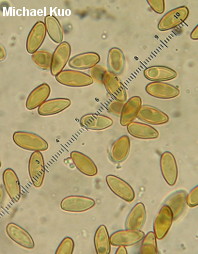| Major Groups > Boletes > Red-Pored Boletes > Boletus luridus |

|
Boletus luridus [ Basidiomycota > Boletales > Boletaceae > Boletus . . . ] by Michael Kuo This impressive mushroom, associated primarily with oaks in eastern North America, is a blue-staining bolete with a red to orange pore surface, a brown to brownish cap, and a stem decorated with prominent reddish reticulation. Several North American species will meet this broad description, and most of them lack official names. The true Boletus luridus is a European species first named in the 18th century; it is not likely that our North American versions actually represent the same phylogenetic species, although they are morphologically very similar. Here I have described and illustrated the version of "Boletus luridus" I collect in the Midwest. Description: Ecology: Mycorrhizal with oaks and other hardwoods; growing alone, scattered, or gregariously; summer and fall; widely distributed east of the Rocky Mountains. Cap: 4-12 cm, convex, becoming broadly convex in age; dry; finely velvety or nearly bald; brownish orange at first, becoming rusty brown to medium or dark brown; bruising dark blue to nearly black. Pore Surface: Dull orange when young; orangish red to reddish orange at maturity; bruising promptly blue; 2-4 pores per mm; tubes to 15 mm deep. Stem: 4-9 cm long; up to 3 cm thick; tapering to the apex; slightly club-shaped when young, becoming more equal; often with a tapered, rooting portion; prominently reticulate with vertically elongated, orange to red reticulation; often with a red to wine red, velvety base; yellowish to orangish above and reddish below; bruising and discoloring blue. Flesh: Whitish to yellow in the cap; yellow to red in the stem; bluing when sliced. Odor and Taste: Not distinctive. Chemical Reactions: Ammonia negative to orangish or yellowish on cap; yellow to orangish on flesh. KOH dark red on cap; dull orange on flesh. Iron salts olive gray on cap; negative to dull olive yellow on flesh. Spore Print: Olive brown. Microscopic Features: Spores 11-14 x 4.5-6 µ; broadly fusiform to nearly ellipsoid; smooth; brownish in KOH. Hymenial cystidia fusiform; hyaline to brownish in KOH; to about 50 x 15 µ. Pileipellis a tightly packed layer of repent and erect, brown-encrusted elements 2.5-5 µ wide; terminal elements subfusiform, or cylindric with rounded apices. REFERENCES: Schaeffer, 1774. (Fries, 1821; Saccardo, 1888; Singer, 1945; Snell & Dick, 1970; Smith & Thiers, 1971; Grund & Harrison, 1976; Smith, Smith & Weber, 1981; Breitenbach & Kränzlin, 1991; Both, 1993; Bessette, Roody & Bessette, 2000; Binion et al., 2008.) Herb. Kuo 07140402, 08240507, 07010701, 07141402. This site contains no information about the edibility or toxicity of mushrooms. |
© MushroomExpert.Com |
|
Cite this page as: Kuo, M. (2015, January). Boletus luridus. Retrieved from the MushroomExpert.Com Web site: http://www.mushroomexpert.com/boletus_luridus.html |
